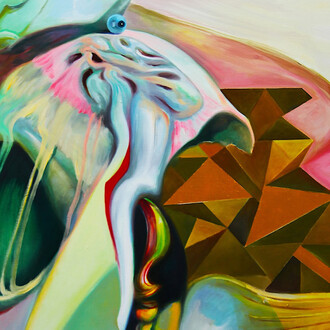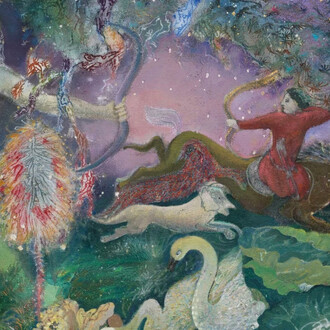Fragment Gallery presents the exhibition Dawn to dusk, featuring works by Caroline Absher, Jacob Todd Broussard, Damien H. Ding, Alannah Farrell, Anthony Goicolea, Haley Josephs, Alejandra Moros, Serolod, and Li Wang.
Dawn to dusk suggests light as a transformative force, revealing layers of intimacy, reshaping familiar forms, and challenging perceptions of the known. Across a spectrum of artistic practices, this exhibition delves into the symbolic and psychological dimensions of “mysterious light,” examining how illumination serves as a metaphor for transformation, self-discovery, and the merging of past, present, and imagined futures. Through these diverse perspectives, Dawn to dusk invites viewers to inhabit the in-between spaces of perception, emotion, and reality. It is also a meditation on light as both subject and symbol—an agent of revelation that guides us through the psychological and symbolic thresholds of shared and individual narratives.
Alejandra Moros’s distinctive approach to painting involves manipulating light and color to reinterpret zoomed-in body parts and familiar objects sourced from video stills and iPhone photos. “Manipulating light and color allows me to participate in the transformation of my source images while still feeling indebted to and appreciative of them as subjects”, she explains. This process becomes a tangible extension of her associative thinking, where memory and imagination intertwine in a dynamic exploration of adaptation and evolution.
Echoing futuristic worlds, the exhibition conjures surreal atmospheres where artificial light—neon hues and glowing reflections—blurs the boundaries between reality and dreamscape. Caroline Absher’s talismanic paintings act as both protective objects and portals, brimming with energy that captures the unseen, nocturnal hum of life. “I tend to think of paintings as windows or portals, but recently I have been thinking of them as objects. Certain paintings carry a lot of energetic power. I have been making paintings that feel to me like protective spells over whoever crosses their path”, she notes. Absher’s works oscillate between serenity and tension, embodying light as a dual force: comforting yet enigmatic.
The psychological resonance of light and darkness acts as symbols of the conscious and unconscious. Haley Josephs explores this duality through vibrant, surreal works, portraying figures in transcendent landscapes where light and shadow become metaphors for mortality, femininity, and personal empowerment. “An onlooker standing at a cliff faces out to the sea. The churning tide and cloudy mixed with a blue horizon represent the road ahead. The deep fluorescent pink-red color on her neck symbolizes not just the sun at her back but also the deepness within. The yonic shape exerts heat and intensity, symbolizing eternal feminine principles as the source of the painting’s power”, Josephs explains. Her exploration of the "eternal feminine" transforms dawn and dusk into potent thresholds of self-discovery and liberation.
Anthony Goicolea’s figurative works inhabit moments of solitude and yearning, where fragility and strength coexist. His cinematic compositions blend realism and surrealism, capturing the essence of life’s contradictions: innocence and imperfection, isolation and hope. Through subtle humor woven into melancholic tones, Goicolea reflects on the beauty and absurdity of life, encouraging viewers to embrace its complexities.
This dynamic tension between the tangible and intangible continues in Damien H. Ding’s meditative piece, which balances stillness and velocity to reveal a sense of transcendence. His “rock-egg” motif evokes primordial narratives, while illogical structures hint at the fragility and power of civilization’s origins. “The rock-egg is both a form potent in its weight but also a cold instigator of events in its unstable form. The simplistic figure in the middle acts as the holder of pressure, holding the rock up and magically levitating against an illogical stool structure which would inevitably fall apart if the figure comes into contact with it”, Ding observes.
Similarly, Serolod’s monochromatic painting The Exit dissolves the boundaries between figure and environment, channeling Einstein’s theory of relativity to suggest an infinite interconnection between matter, time, and space. “Everything is composed of dots, and within the dot is an infinite amount of division”, Serolod reflects. “I’m exploring color theory, the borders of skin and environment, and the relationship between the creation and destruction of an image.” Serolod’s work is uniquely idiosyncratic in her depictions of the figure, riffing on the pictorial traditions of figure painting, Impressionism, and photography. Three main elements exist in her work: the figure, mark-making, and the translation of digital imagery. In her process, Serolod focuses on conveying the loneliness of outcast personas while maintaining a sense of dignified solidarity with their lonely characteristics. There’s never a sense of outright individualism in her figures, but rather a oneness with their environments.
Intimacy and memory emerge in deeply personal works by Li Wang, whose portraits of queer Chinese men reclaim spaces of vulnerability and desire often absent in Western art. In paintings such as Memory in Miami I, Wang transforms nostalgic moments into surreal, light-infused atmospheres, where reflections off a vintage car mirror fragmented emotions and longing. “After my breakup with my ex, I finished Longing is like a snake crawling through the grass, he shares. “I sat alone, immersing myself in memories to escape the reality of the situation”.
Jacob Todd Broussard expands this focus on queer history and personal narrative with layered, time-defying paintings and sculptures. There are two works presented in the show: the large-scale painting Did we discuss distance (The history of touches), accompanied by Attempted light cone (for Martin), a sculpture made of a vintage brass lamp. The painting contains numerous subtle traces of various elements, particularly art historical ones—for instance, a Forrest bess monograph leans against the side of the entertainment system, a Polaroid of Bess is taped to it, and a postcard of the Dying galatian is also present (which appears again in the collage for the lamp sculpture featured in the exhibition). The blue static screen of the TV is a nod to Derek Jarman's Blue. The sculptural object is enriched and reworked with collages, mixed media, and drawings. The artist describes it as a “light cone”, weaving light into metaphors for time and space using references to space-time relativity theory.
Finally, Alannah Farrell’s charged portraits of their queer community present dawn and dusk as liminal states of identity and selfhood. In Sam and Richard, soft, glowing light filters through a window, while a cat’s luminous green eyes pierce the canvas, evoking a delicate tension between presence and absence. Farrell captures these moments with emotional depth, using light to explore the connection between time, transformation, and intimacy.
















